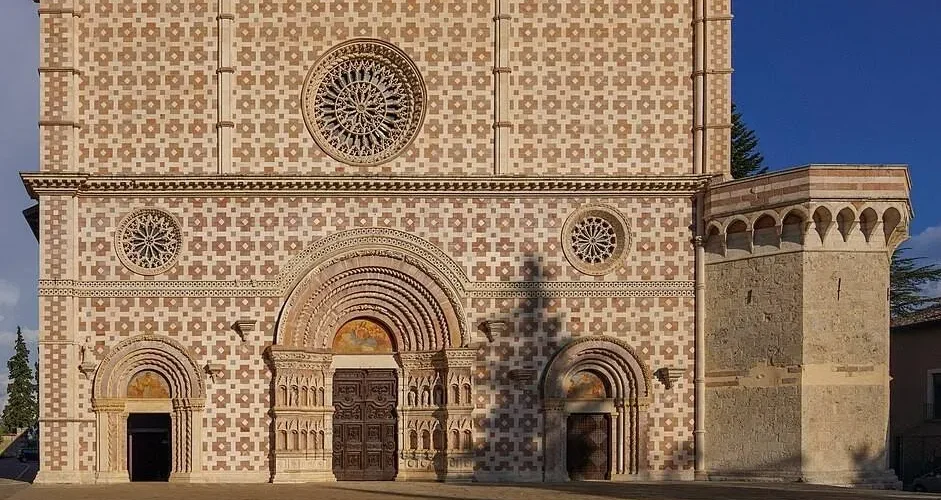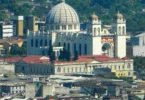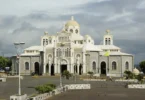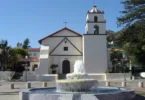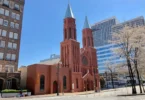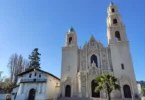Introduction
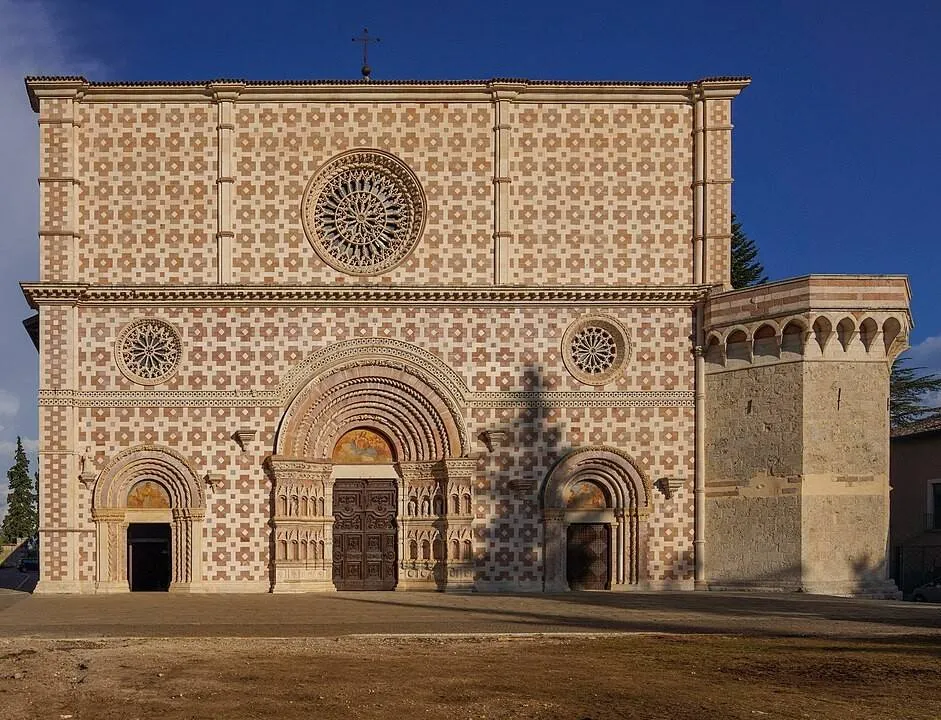
The Basilica of Santa Maria di Collemaggio is a significant religious structure located in L’Aquila, just outside the city walls, on the hill of the same name. It was founded in 1288 by Pietro da Morrone, who later became Pope Celestine V and was crowned here on August 29, 1294. The basilica is regarded as the finest example of Abruzzo architecture and has become a symbol of the city. In 1902, it was declared a national monument.
Since 1327, the basilica has housed the remains of Pope Celestine V, which are now preserved in the mausoleum dedicated to him. This mausoleum, designed by Girolamo da Vicenza in 1517, was built by a master who worked with Andrea Palladio. The basilica is also known for hosting the annual Perdonanza Celestiniana, the first-ever papal jubilee, which was established by the Bull of Forgiveness in September 1294. This event is celebrated today and is recognized by UNESCO as part of the world’s intangible cultural heritage. As a symbol of this sacred occasion, the basilica features a Holy Door on its side façade.
The church, which holds the title of minor basilica along with San Bernardino and San Giuseppe Artigiano, has been remodeled several times throughout its history, particularly due to damage from frequent earthquakes. It reflects a blend of various architectural styles. After the devastating earthquake in 2009, the basilica underwent significant consolidation and restoration work, which was completed in 2017. In recognition of these efforts, it received the European Union Cultural Heritage Award in 2020.
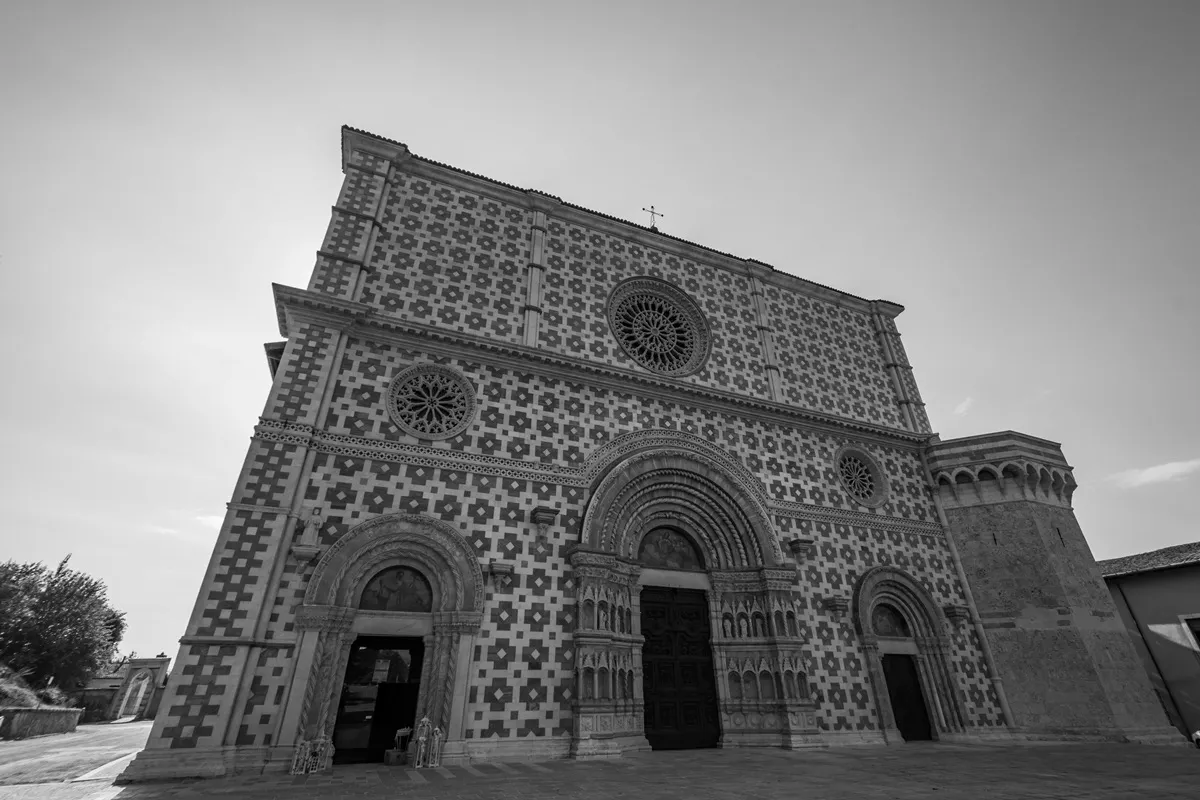
Origins and Early Construction
Before the construction of the Basilica of Santa Maria di Collemaggio, the area of Collemaggio, located just outside the city walls of L’Aquila, likely hosted defensive structures, such as a castle or tower. Additionally, a religious building known as the Church of Santa Maria dell’Assunzione once stood there, though only remnants of its ancient gallery remain today. It is believed that Pietro da Morrone, later Pope Celestine V, sought refuge in this church during his travels to France in the 1270s. Tradition holds that he received a vision in which the Virgin Mary instructed him to build a church in her honor. Some historians suggest that this early church existed before 1287, though archaeological findings have yet to support this. The original structure may have followed the design of other Celestinian foundations, such as the hermitage of Santo Spirito a Maiella.
Construction Phases (1287–1461)
In 1287, Celestine monks from the Badia Morronese purchased the land and began construction of the basilica. By August 25, 1288, the church was consecrated, although construction was still ongoing. The initial church likely had five apses, but some scholars, such as Fabio Redi, argue that it was originally smaller with a shifted longitudinal axis. Charles of Anjou is credited with financing the project, and French Cistercian monks likely contributed to its construction.
In 1294, Pietro da Morrone was elected pope and crowned in the basilica, marking the church as a significant location. Although Celestine V’s papacy lasted only four months, his renunciation of the papacy and subsequent imprisonment in Fumone contributed to a hiatus in construction. The church’s significance increased after Celestine V’s canonization in 1313, and his relics were transferred to the basilica in 1327. Construction resumed after the 1315 earthquake, which caused the collapse of the apse. Over time, the church’s design shifted, and a three-nave structure replaced the original five-apse plan. Additional work followed another earthquake in 1349, with the church’s choir becoming a standout feature of the building.
Renovations and Artistic Flourishing (15th–17th Centuries)
The 15th century saw the completion of the basilica’s façade, an architectural masterpiece of Abruzzese design. The church also underwent significant remodeling following a 1456 earthquake. During the 16th century, the mausoleum of Celestine V, designed by Girolamo da Vicenza, was constructed to house the remains of the saint. Further artistic works, including altars and frescoes, enhanced the basilica’s interior. By the 17th century, the basilica embraced a Baroque style, with stucco and decorative elements transforming the space. The external renovations, however, remained relatively modest during this period.
Baroque Restoration and the 18th Century
Following the 1703 earthquake, restoration work began promptly, and by 1706, the basilica’s walls and vaults were restored. Baroque-style alterations, such as new altars and balustrades, were completed by 1721. The church also saw the addition of decorative features typical of the 18th century, contributing to the basilica’s grand interior appearance.
19th Century Decline and Renewal
In the 1800s, the suppression of the Celestinian order led to a period of crisis for the basilica. Despite this, the Collemaggio area gained new importance, hosting events such as the athletic games associated with the 1903 Universal Exhibition. In the early 20th century, after suffering damage from the 1915 Marsica earthquake, the basilica underwent significant restoration, including the reconstruction of its dome in the 1960s.
20th Century Restoration and Controversies
From 1969 to 1973, the basilica underwent a controversial restoration under the supervision of Mario Moretti, which involved removing much of the Baroque decorative work to restore its original Romanesque character. This intervention, though contentious, revealed valuable frescoes that had been hidden under the Baroque layers. During the restoration, the remains of Celestine V were temporarily moved to the monastery of San Basilio.
Recent Events and Restoration after the 2009 Earthquake
The 2009 earthquake caused severe damage to the basilica, including the destruction of the transept and parts of the nave. After the earthquake, the basilica was temporarily closed for safety and reopened in December 2009 as a pro-cathedral, while the main cathedral of Saints George and Maximus was rendered unusable. Full restoration work began in 2015, with funding provided by Eni. The restoration focused on rebuilding the transept and repairing damaged pillars and frescoes. The work was completed in December 2017, and on December 20, the basilica was reopened to the public. The restoration was awarded the European Heritage Award in 2020, recognizing the effort to preserve this iconic structure.
Architecture of Basilica of Santa Maria of Collemaggio in L'Aquila, Italy
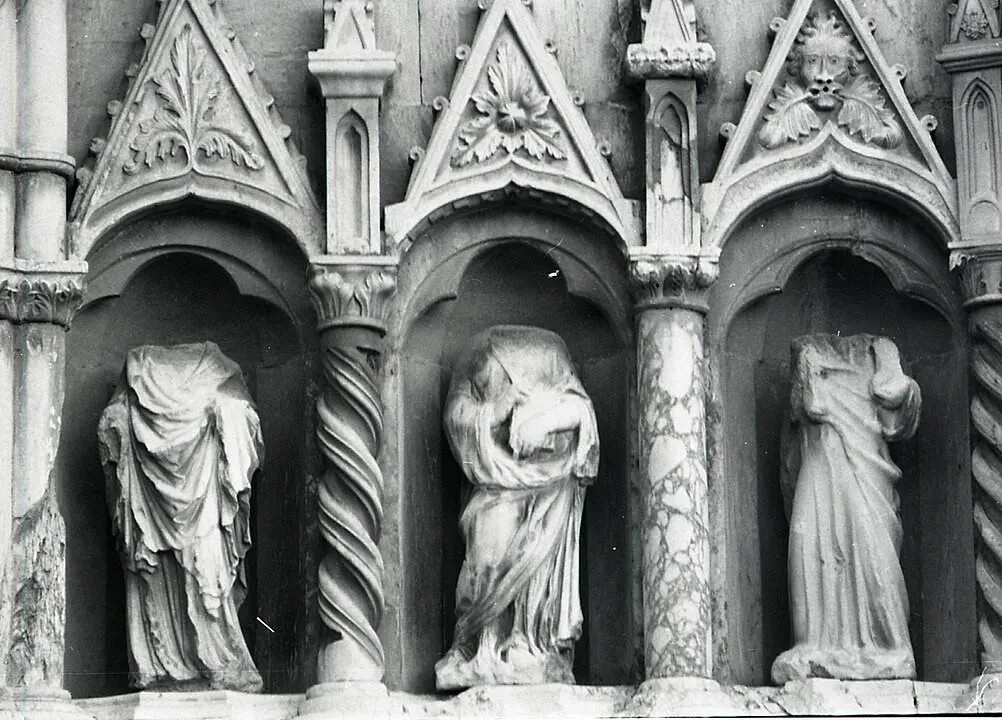
The Basilica of Santa Maria di Collemaggio is situated on a small promontory just outside the walls of L’Aquila, to the southeast of the city. Positioned centrally between the city walls and the royal cattle track connecting L’Aquila to Foggia, the site offers a panoramic view of the Gran Sasso d’Italia on the left and Monte Ocre with the Velino-Sirente mountains on the right. This location also holds astronomical significance, as the basilica is oriented in alignment with the day of the Assumption of Mary, to whom the building is dedicated.
Access and Layout
Historically, the first encounter with the basilica was from below and laterally, with the main route through Porta Bazzano and what is now Via Caldora. Over time, access was expanded, especially through a gap in the city walls from the San Michele area, leading to the construction of Viale di Collemaggio in the late 19th and early 20th centuries. This adjustment, while simplifying the basilica’s complex volumetric structure, accentuated its monumental character, especially when paired with the large green space in front of the facade, reminiscent of the Pisa Cathedral Square.
Facade of the Basilica
The facade of Collemaggio is regarded as the pinnacle of Abruzzo’s architecture and one of the finest examples of Romanesque-Gothic Italian design. It replaced a previous facade after the 1349 earthquake and is believed to have been completed in the early 15th century. The facade is structured with a square form, divided into vertical and horizontal sections using a consistent pattern of squared stone blocks. It showcases nine sectors, including three portals and three intricate Gothic-style rose windows, the central one featuring double rows of columns and arches. These decorative elements were influenced by both Venetian and Oriental styles, incorporating the white and red stones that reflect the civic colors of L’Aquila.
The design of the facade is asymmetrical, with the main portal and the central rose window not aligned on the same axis, and the lateral portals spaced unevenly. The decorative elements reveal a blend of different styles and craftsmanship, with Romanesque features on the right side and Gothic influences on the left. The facade’s construction spans the late 14th to early 15th centuries, with some sources suggesting a final phase of work in the 16th century.
Main Portal and Rose Windows
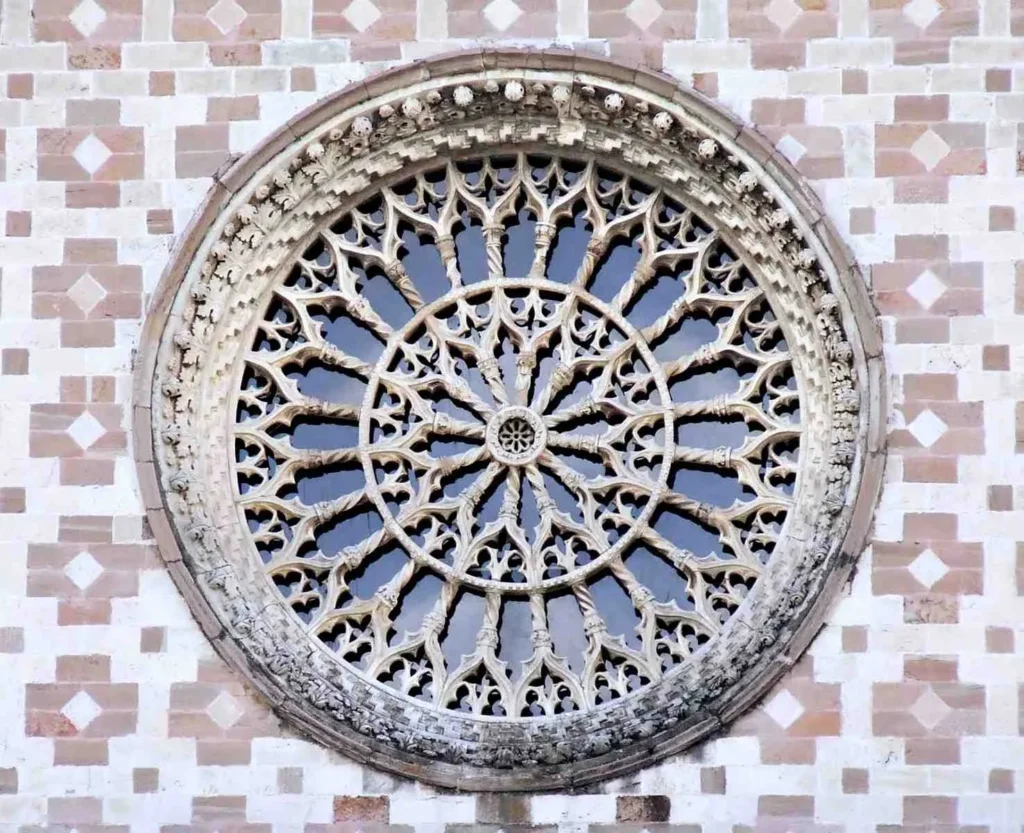
The main portal of the basilica is the oldest of its three entrances and is distinguished by its detailed carvings and ornamental elements, including a high plinth with relief panels and several rows of tabernacles. Above the portal are concentric round arches that once held statues of saints, only a few of which remain today. This portal was likely constructed in the 15th century and may have been the work of Domenico da Capodistria. The side portals mirror the design of the Holy Door and feature similar ornamental elements.
The Holy Door
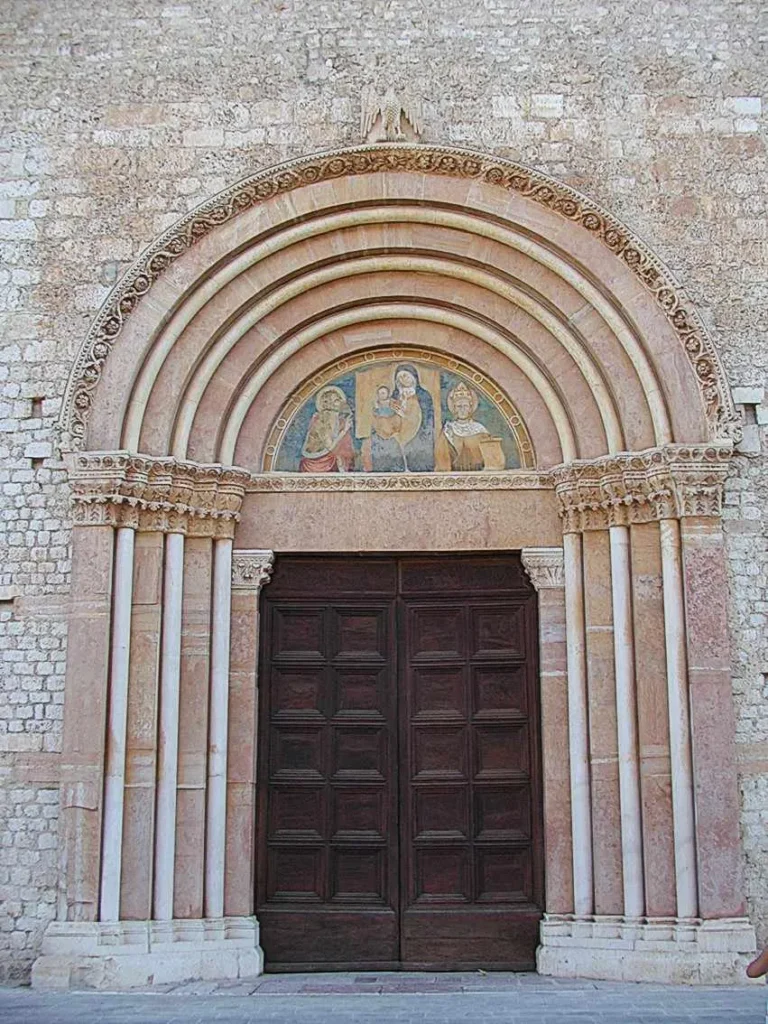
On the left side of the basilica stands the Holy Door, a monumental portal associated with the Celestinian Forgiveness. Open for just one day each year during the L’Aquila Jubilee, it grants plenary indulgence to those who pass through it, provided they are repentant and confessed. The Holy Door, built at the end of the 13th century, is adorned with intricate carvings in pink stone, demonstrating a connection to local traditions. The lunette above the door features a fresco of the Madonna and Child with Saints John the Baptist and Celestine V, along with the Bull of Forgiveness issued by Celestine V in 1294.
Interior of Basilica
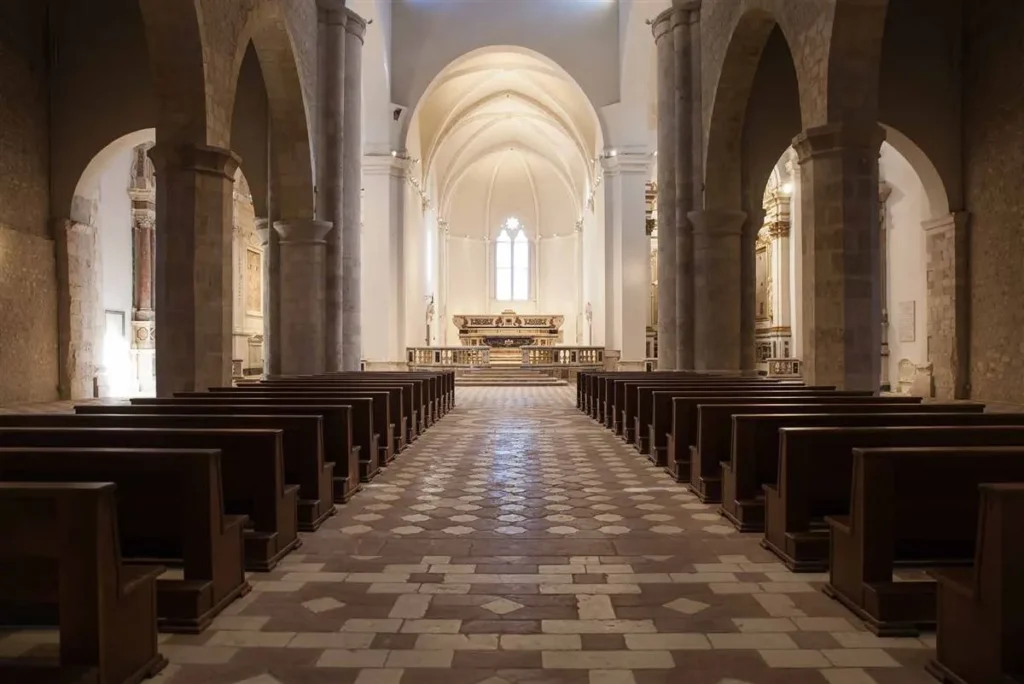
The basilica’s interior is characterized by a simple Romanesque plan, with three naves divided by ogival arches supported by octagonal pillars. The right nave is notably wider than the left, a feature also seen in Santa Giusta. The interior of the basilica reflects a duality between Cistercian simplicity and Gothic depth, with the design of the church’s spatial organization complementing the humble lifestyle of its founder, Pietro da Morrone. The exposed wooden ceiling replaced a Baroque coffered ceiling that was dismantled during 20th-century restorations.
Frescoes and Artistic Elements
The basilica was once covered in frescoes, many of which were lost during the controversial 20th-century restorations. Some fragments remain, such as the frescoes of St. John the Baptist and a crowned saint on the counter-façade. The right aisle features several important frescoes, including depictions of the Madonna of Loreto, the Assumption of the Virgin, and the Crucifixion, all dating back to the early 15th century. The transept, rebuilt after the 1703 earthquake, retains its 18th-century Baroque elements, while the apse system underwent significant changes in the 14th century.
Mausoleum of Celestine V
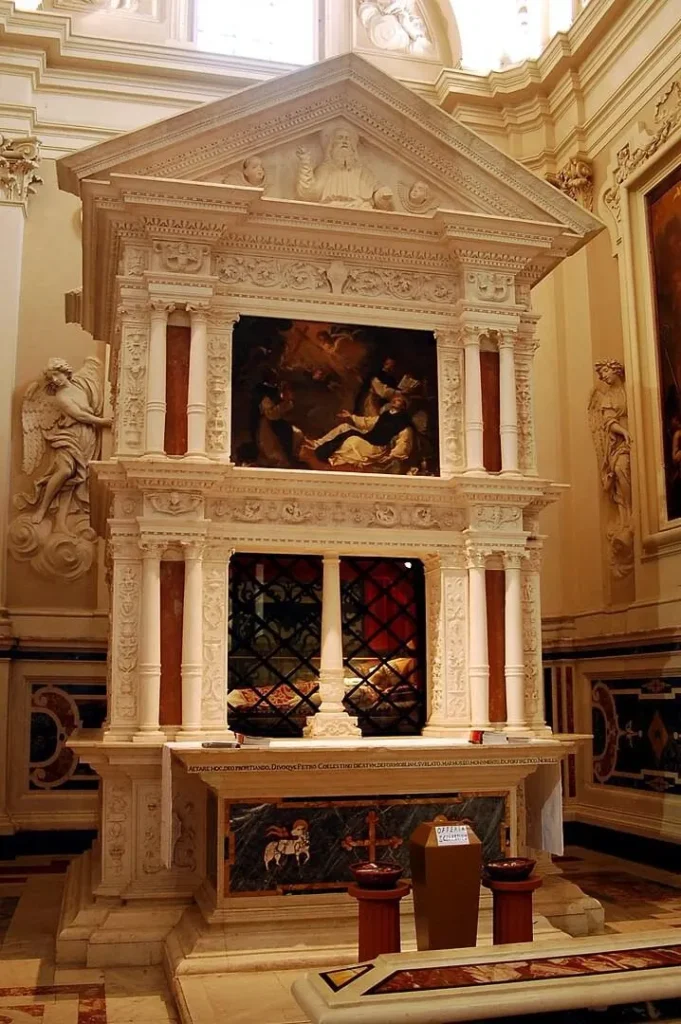
The tomb of Pope Celestine V is located in the right apse of the basilica, within a mausoleum erected in 1517. The mausoleum, designed by Girolamo da Vicenza, features a square plan and two levels, with decorative columns and a gilded wooden urn. Originally, the urn was made of silver but was stolen several times throughout history. The mausoleum gained attention in 1988 when Celestine V’s body was stolen and later recovered.
Pipe Organ
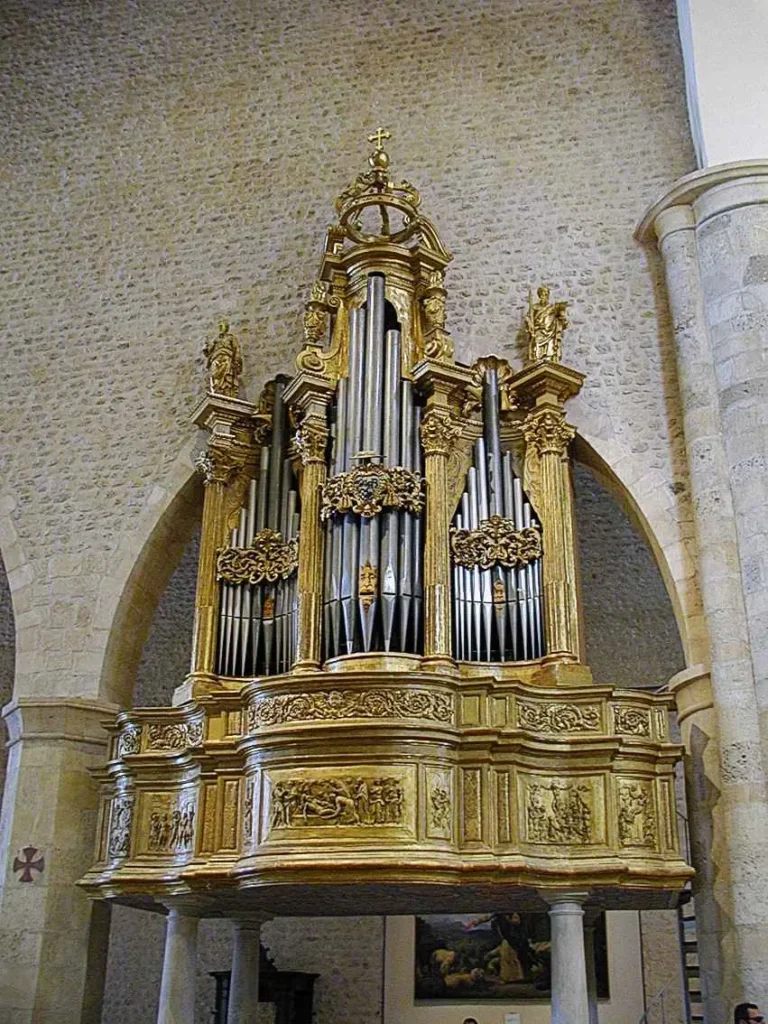
The basilica once housed a historic pipe organ, which was destroyed in the 2009 earthquake. Originally attributed to Luca Neri di Leonessa, the organ was relocated to Collemaggio in 1709 after the 1703 earthquake. Despite its destruction, the organ’s case was restored in 2018, though the sound mechanism was not rebuilt.
Flooring
The basilica’s stone flooring is notable for its distinctive design, which mirrors the chromatic motifs seen on the facade. The pattern includes white and red diamond shapes, oriental motifs, and a labyrinth in the central part of the floor. This labyrinth, featuring six concentric circles, holds mystical significance and is one of the most striking elements of the basilica’s interior.
Monastery
Adjacent to the basilica is the monastery, which suffered damage in the 1456 earthquake but was reconstructed by 1461. The monastery’s plan includes a square cloister with a portico, and its refectory features frescoes from the 16th century, including a Crucifixion attributed to Saturnino Gatti. After the suppression of the Celestine Order in 1807, the monastery underwent cultural transformation.
Feast Day
Feast Day: 15th August
The Basilica of Santa Maria di Collemaggio in L’Aquila, Italy, is primarily dedicated to the Assumption of Mary, with the feast day falling on August 15. This day marks the celebration of the Virgin Mary’s ascent to heaven, a significant event in the Catholic liturgical calendar.
Church Mass Timing
WINTER
Weekdays : 5.30pm
Sunday : 11.00am and 5.30pm
SUMMER
Weekdays : 6.30pm
Sunday : 11.00am and 6.30pm
Church Opening Time:
Monday : 9:00 am – 6:30 pm
Tuesday : 9:00 am – 6:30 pm
Wednesday : 9:00 am – 6:30 pm
Thursday : 9:00 am – 6:30 pm
Friday : 9:00 am – 6:30 pm
Saturday : 9:00 am – 6:30 pm
Sunday : 9:00 am – 6:30 pm
Contact Info
Address :
Piazzale Collemaggio, 5, 67100 L’Aquila AQ, Italy
Accommodations
Connectivities
Airway
Ciampino Airport(CIA) to Basilica of Santa Maria of Collemaggio in L’Aquila, Italy distance between 1 hr 20 min (126.1 km) via A24.
Railway
L’Aquila Railway Station to Basilica of Santa Maria of Collemaggio in L’Aquila, Italy distance between 10 min (4.6 km) via V.le della Croce Rossa.

